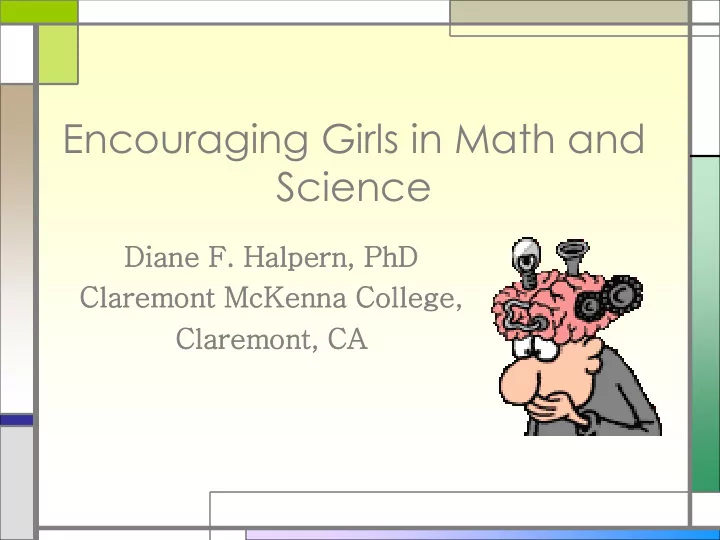

Encouraging Girls in Math and Science Dia iane F. . Halpern, PhD Cla laremont McKenna Coll llege, laremont, CA Cla
http://dww.ed.gov/
Overview Video
Science, like Love, is a Many-Splendoured Thing □ Female graduation rates: □ 50% in medical school □ Almost 75% in veterinary school □ 44% of PhDs in biology/ life sciences □ Women are succeeding in some sciences! Compared to 29% in mathematics 17% in engineering 22% in computer/ information sciences What is Holding Men Back, They Obtain Only 32% PhDs in psychology 37% PhDs in health sciences 34% PhDs in education
Brief Summary of the Evidence □ Thinking about intelligence as something that is not “fixed,” but can be improved with effort. □ If child’s goal is to “look smart,” she will avoid challenging tasks. □ If child believes abilities can be improved, then more likely to respond to challenges with increased effort.
How to carry out the recommendation □ Discuss neuroscience research that shows that brains grow new synaptic connections when new material is learned. □ Remind students that over time and with effort understanding and problem solving will get easier.
Brief Summary of the Evidence □ Specific informational feedback (you worked hard) better than general praise (you’re smart). □ Specific problem in logic better than just saying problem is incorrect.
How to carry out the recommendation □ Highlight the importance of effort for success at difficult tasks. □ Grades matter, but try to also focus on learning opportunities that de- emphasize grades.
Brief Summary of the Evidence □ Negative stereotypes can affect performance in some test-taking situations □ “Stereotype threat” can be reduced or eliminated by exposing women to high-achieving role models who are “like them.”
How to carry out the recommendation □ Assign readings about women scientists. □ Call attention to current events that highlight the achievement of women in science and math. □ Invite women or older students to class to serve as role models. □ Counter “Stereotype threat”
Automatic Operation of Sex Role Stereotypes □ Categorization is a fundamental property of information processing □ Stereotypes are one example of categorization processes □ Stereotypes operate without our conscious awareness (implicitly) □ Stereotypes are activated automatically (we cannot stop them) □ Stereotype threat — under some conditions, activation of negative stereotypes about one’s group can depress performance
Stereotype Threat Apprehension arising from the awareness of a negative stereotype or personal reputation in a situation where the stereotype is relevant, and thus confirmable
General Hypothesis When the ability is personally important, the apprehension can be disruptive; it can lead to distraction and anxiety, which interfere with intellectual performance, short term memory, etc. In other contexts, it can undermine motivation and self-confidence.
Powerful Sex Role Socialization Practices are Found Throughout the Life Span □ “Math class is tough.” “I love dressing up.” “Do you want to braid my hair?” --Teen Talk Barbie’s First Words □ “Attack the Cobra Squad with heavy fire power”; “When I give the orders, listen or get captured.” --G. I. Joe
Brief Summary of the Evidence □ In general, boys are often more interested in science, technological, and mechanical activities and girls are more interested in person-oriented activities. □ Once curiosity is sparked, long-term interest will follow.
How to carry out the recommendation □ Embed math and science in interesting contexts (e.g., saving the planet from aliens). □ Use active problem solving to get students engaged in their work.
Brief Summary of the Evidence □ Spatial skills performance is correlated with performance in math and science □ Several studies show that spatial skills can be enhanced with training.
Gender differences □ Males > females: Standardized test performance □ Females > males: Classroom performance □ Classes biased □ Tests biased?
Tests scores mean a lot □ Student’s own estimate of ability □ Admission into college □ Generalizations about male and female ability by authorities.
Discrepancies □ Test performance: not directly tied to what is learned in class. □ Require range of solution strategies (i.e. visuospatial ability). □ Course performance: familiar use of what is learned in class □ Attendance and other behaviors also important
Visuospatial ability □ Ability to create a representation of information in a problem □ Mental rotation, inversion, twisting, etc… of pictorially presented visual stimuli (McGee, 1979). □ Accounts for some gender differences in performance (Tartre, 1990).
Mental Rotation Task
Accounting for gender diff’s □ Statistical removal of effects of mental rotation from SAT-M scores (Casey, et al., 1995). □ sex differences eliminated □ Sorby and Baartmans (2000): visuospatial training course at Michigan Technological University
How to carry out the recommendation □ Encourage girls to play with toys that require spatial knowledge. □ Teach girls to image and draw math and science assignments. □ Provide opportunities for specific training such as mental rotation of objects.
Conclusions □ We can increase the number of girls and women who go into math and science careers. □ These are all good practices that will enhance performance and interest for boys.
Recommend
More recommend